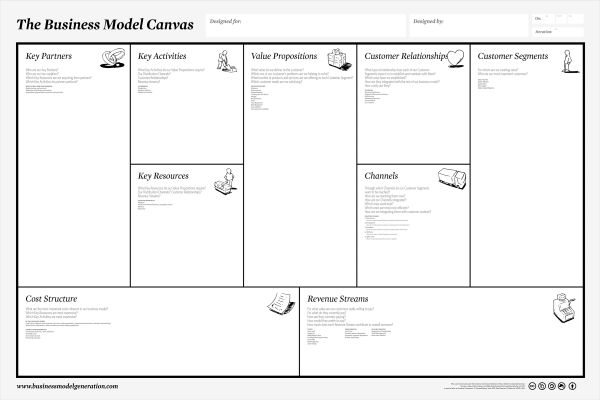What to do if there is no time to write a business plan
Detailed business plan or “on a napkin”?
A business plan is a document that investors are forced to write, but which they do not read "- Steve Blank (Steve Blank)
A detailed business plan of a new idea, worked out on several dozens of pages, of course, looks solid. And, perhaps, some inspire more confidence - after all, a pile of paper suggests that there is not only an idea, but market research has already been done (the quality of this research is not affected), competitors, in the end, time and effort are invested!
But how relevant is this for an IT business? While a startup’s business plan is being written, the market is being researched and watched; most likely, a similar idea is already being implemented by another team that did not have a business plan at all. Or she is conducting “reconnaissance by force” since she has resources for that. The IT market is changing quite quickly compared to traditional markets, so often the business plan becomes obsolete even before its completion.
')
A simpler and faster option, the business plan “on a napkin” as opposed to, includes the main theses, as a rule, a description of the problem, which is solved plus the answer to the main question “where is the money”.
But there are also tools that are looking for a compromise between the detailed plan and the “napkin”, and I want to consider three tools: SWOT analysis, Scorecard and Business Model Canvas
They allow you to describe the idea of business on one, maximum two sheets. This is clear, it helps to concentrate on expressing the essence of the business, but on the other hand it is convenient to discuss and make changes in this way.
SWOT analysis
SWOT analysis rather compactly describes a business idea in four main parameters: strengths, weaknesses, opportunities and threats, respectively.
Example:

Disadvantages: the parameters are fairly general, there is no clear separation between the internal parameters of a business (for example, a team) and external (market, marketing)
Pros: only four parameters, the interpretation of which is quite clear. The approach can be used to assess not only the external activities of the company, but also internal.
Scorecard
A less comprehensible tool for the unprepared, the essence of the approach is not just to describe each of the parameters in words, but to evaluate it in points.
Example:

One of the well-known evaluation tables is proposed by Thomas McKnight, the author of the book “Will Fly? How to find out if your business idea has wings before you jump ”(Russian translation published in 2007). The author of the book, by the way, has repeatedly conducted trainings for top managers of Russian oil companies.
This evaluation table includes 44 parameters, each of which is estimated in points from -10 to +10, and with a different “weight” of the parameter (multiplier, which expresses the significance ”of this parameter from 1 to 3)
The parameters include both quite understandable (especially for Russia), for example, “Relations with the ruling circles”, and more blurry as “Passion” (how much do you rate your personal passion for the project). Each parameter is described in detail in the book.
The idea will “fly up” if after filling in the table 70% of the maximum amount of points is accumulated. If not, then you will see for yourself what parameter you need to pay attention to.
After some experience using the evaluation table, you can add try to enter some of their parameters. The table itself can (and should be adjusted) as the company develops, and track current strengths and weaknesses.
Cons: to understand each parameter you need to read a book.
Pros: although the assessment is made quite subjectively, the difference between the two business ideas can be expressed in concrete numbers. After a certain workout, you can fill in a table in 30-40 minutes or less. As the author of the book recommends - if you heard an idea, before discussing it, evaluate the idea from the table and see for yourself whether the idea is worth it or not.
Canva Business Models (Business Model Canvas)
A relatively new approach, first proposed by Alexander Osterwalder in 2004, and gaining popularity, especially among startups. The origins of this method come from Steve Blanc's classic book “The 4 Steps To Epiphany”. In the autumn of 2011 it is planned to publish the Russian translation of the book by A. Osterwalder ““ Business Model Toolbox ”.
The business model is described on one sheet, divided into 9 blocks.
Example:

copyright www.businessmodelgeneration.com
9 blocks (parameters) cover the main aspects of business:
- Infrastructure (key activities, key resources, partners)
- Offer (core value of products and services offered by the company)
- Customers (customer segments, sales channels, development of customer relations)
- Finance (basic costs, incoming cash flows)
Pros: clearly and sufficiently to evaluate the ideas of start-ups and IT business. It can serve as a good basis for writing a detailed business plan. Convenient for continuous changes.
Cons: not carried out a qualitative assessment as in the method with the evaluation table.
Conclusion:
The tools listed above are not mutually exclusive and can be used together. Their main advantage is that they are available, do not require much time and special education. And there is no doubt that by sketching a SWOT analysis, assessment table or outline of a business model, you can better understand the essence of your business idea, its current advantages and disadvantages.
Source: https://habr.com/ru/post/126795/
All Articles